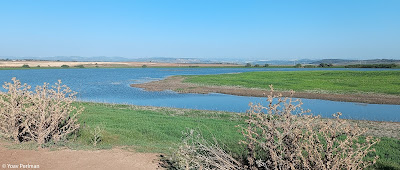This summer keeps giving. Early morning streak-continuation birding, schoolrun, coffee in the garden with my wife, phone beeps: Rony Livne and his team had just caught a Basra Reed-Warbler at his site, Kfar Menachem!!! Conveniently it's a short drive away. I jumped in to the car and enjoyed this excellent bird just before it was released. Thanks Rony and the team!
I have a bit of history with this bird in Israel. In 2006, the late Amit Geffen and I worked together in Agamon Hula Ringing Station. When our accommodation shifted to kibbutz Lehavot Habashan, we looked for local afternoon ringing options. On our first afternoon session at the kibbutz's fishponds we caught three Basra Reed-Warblers (!), a recently-fledged young and two adults, a male and a female, both with physiological evidence for breeding (brood patch and swollen cloaca). This is a photo from July 4, 2006 - adult Basra Reed-Warbler on left, recently-fledged juvenile on right:
Over the next days we caught a couple more. This was the first breeding record in Israel of a bird that back then was a mega rarity in Israel, globally threatened and declining, and at that time unknown to breed away from the marshes of southern Iraq. Understandably, this breeding record generated some interest. Next year, in 2007, a few Basra Reeds returned to the site, but there were no signs of breeding. In 2008 only one individual was found, again without signs of breeding. This photo is from May 24, 2008:
Since then, Basra Reed-Warbler has returned to its former rarity status in Israel, as a rare late-spring/summer migrant, just about annual. Almost all records involve birds trapped by ringers, in Eilat and northern valleys. Today's record is the first in central Israel.
Basra Reed-Warbler is globally Endangered. Though its global population trend may have stabilized during the 2000's, it seems to be undergoing population declines again as a result of habitat loss and the effects of climate change. Its core breeding area is in southern Iraq, and in recent years it was found breeding also in adjacent parts of Iran, and in Kuwait. Additionally, there were indications that it may be breeding along the Euphrates north into Syria and even Turkey. I would assume that birds migrating through Israel are heading to or from more northerly breeding grounds than S Iraq.
This photo is from the stunning Ngulia, Tsavo West NP, Kenya, December 7, 2010:
























